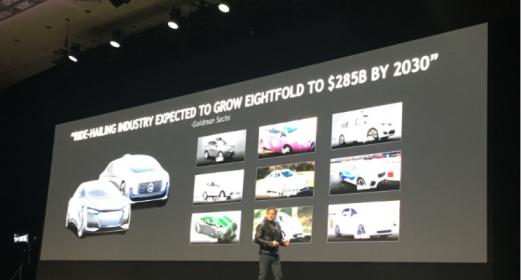There hasn’t been this much excitement in Munich since the 1920’s. Nvidia’s great pivot was on display at the GPU Technology Conference Munich 2017. Digital dashboards are out and robotaxis are in as Nvidia narrows its focus on the tip of the automotive industry disruption spear.

To be clear, Nvidia is triangulating on the automotive industry from a number of different angles ranging from augmented and virtual reality design tools (Holodeck) to server technology implemented across the spectrum of cloud service providers. It just so happens that Nvidia is also trying to reduce the “supercomputer-in-the-trunk” phenomenon of self-driving cars down to a device the size of a license plate.
Notes Nvidia: “Of the 225 partners developing on the Nvidia Drive PX platform, more than 25 are developing fully autonomous robotaxis using Nvidia Cuda GPUs. Today, their trunks resemble small data centers, loaded with racks of computers with server-class Nvidia GPUs running deep learning, computer vision and parallel computing algorithms. Their size, power demands and cost make them impractical for production vehicles.”
The significance and manifestation of Nvidia’s Pegasus pivot was the introduction at the GTC event in Munich of a license-plate sized device capable of displacing all that trunk-hogging hardware in self-driving cars. Setting aside the cost and performance conversation, the shift of focus at Nvidia to so-called robotaxi startups is a massive turning point for the industry.
Intel, too, has turned away from its prior fixation on infotainment in automotive dashboards. Intel’s tie up with BMW and acquisition of Mobileye was an equally tectonic shift in focus on safety and autonomy.
Nvidia prides itself on being the coolest kid on the technology block – from Jensen’s signature keynote leather jacket (did he borrow that from GM CEO Mary Barra or did she mimic him?) to the whooping and chanting Nvidia fan-boys (at least in Silicon Valley) when the company talks about petaflops and such at press events. But robotaxis? Nvidia? Really?
The big news out of Munich is that Nvidia is seeking to confer its uber-coolness upon robotaxis, by which the company clearly means Uber and Lyft judging by the slide image (pictured above). Of course Nvidia is conflating definitions and business models by using the term robotaxis along with the super-frothy Goldman Sachs forecast of $285B.
The real change that is coming along to blindside the entire transportation industry is multipassenger shared and autonomous transportation vehicles. The mass of startups emerging across the planet is primarily focused on luring consumers out of their individually owned and operated vehicles into shared public transportation resources.
But somehow, announcing to the world that Nvidia was pushing pods and shoving shuttles likely didn’t have the same “Total Recall,” Philip K. Dick sizzle of launching a robotaxi assault on people moving. It doesn’t matter. The bottom line is that Nvidia has taken the first step toward making shared, public transportation cool. What’s not to like?
So, Jensen, bring on the petaflops and let’s save some lives, reduce some emissions and congestion and feel uber-cool in the process. Hail Nvidia! Hail shared vehicles! Hail disruption!
Share this post via:







Quantum Computing Technologies and Challenges